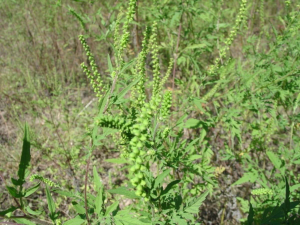Goldenrod are easily recognizable this time of year with its showy yellow flowers held high on stems moving back and forth by autumn winds. A field full of these vivid yellow blossoms is a sight to see with a bright blue fall sky as a background. But too often this plant is blamed for the sneezing, runny nose and itchy eyes that many people suffer while goldenrod is blooming.
The common culprit causing these allergy symptoms is ragweed, not goldenrod.
Ragweed blooms at the same time as goldenrod, August to frost.
Ragweed releases its billions of tiny, lightweight pollen grains into the air this time of year. This windborne pollen causes much of the hay fever problems. Goldenrod pollen is too large and heavy and sticky to be windborne. It relies on insects to carry its pollen. I suppose if you put your nose right up into a cluster of goldenrod flowers and took a big sniff, you might be bothered by the pollen. But otherwise, it is not going to get into your nose.
Goldenrod is an innocent bystander as ragweed remains camouflaged releasing its pollen. Ragweed visually blends in with other green plants. Despite the fact that common ragweed, an annual, can grow three to greater than six feet in height, it just does not get your attention. It is quite common along roadsides, vacant lots and abandoned fields. Its inconspicuous flowers start out as green, similar in color to the leaves, turn a yellowish-green and finally dry to a brown color. They are never showy.
Enjoy the bright yellow flowers of goldenrod this fall. But please do not blame them for your allergies.
- Evaluate and Renovate Landscape During Fall - October 30, 2025
- Summer is Too Hot for Lawn Herbicides - August 23, 2025
- Nuisance Gnats abound in Northwest Florida this spring - June 26, 2025


